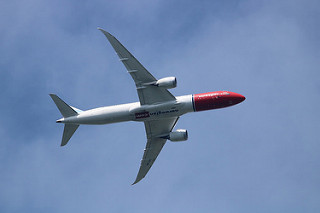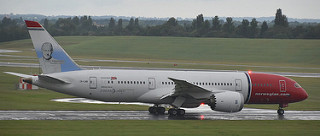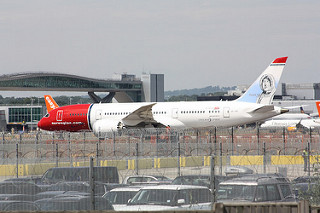Norwegian B788 at Rome on Aug 10th 2019, engine spits parts, hits person and vehicles on ground
Last Update: January 26, 2022 / 18:02:21 GMT/Zulu time
Incident Facts
Date of incident
Aug 10, 2019
Classification
Incident
Airline
Norwegian Long Haul
Flight number
DY-7115
Departure
Rome Fiumicino, Italy
Destination
Los Angeles, United States
Aircraft Registration
LN-LND
Aircraft Type
Boeing 787-8 Dreamliner
ICAO Type Designator
B788
The serious incident of the Boeing B787-8 marks LN-LND occurred due to a technical factor. Specifically, the failure of the IPTB n. 79 was induced by a progressive corrosion-fatigue phenomenon made possible by an improvable the blade design.
The detachment of the IPTB n. 79 induced damage to other parts of the engine, to the aircraft and on ground in the city of Fiumicino.
Organisational aspects, in terms of regulatory framework, probably contributed the event to occur, although 10 previous similar cases were already occurred starting from October 2015:
- the risk assessment for people on ground due to PDA, discussed in CM-21.A-A-001;
- the absence of a clear and more comprehensive definition of high energy debris;
- the absence of any project of revision of the maximum allowable probabilities of occurrence used in the CSs and for the Part 21.
The ANSV analysed the left hand engine:
The maintenance history of the engine has not revealed details that would have prevented the blade from being released in flight. The FDR and EMU data showed that the crew could not realize in advance that there was an anomaly in the engine until the moment the failure occurred. Furthermore, the data recorded together with borescope inspections correctly identified immediately after the event the primary damage: the detachment of the IPT No. 79 blade due to a progressive failure.
The subsequent investigation of the engine made possible to ascertain the sequence of damage.
The failure analysis of the IPT 79 blade confirmed the corrosion-fatigue progressive phenomenon. The initiation was favored by the methodology and type of coating in addition to the base material composition constituting the IPT blades. The absence of cases of IPT blade detachment in service in post-SB 72-H818 engine fleets supports this thesis. The corrosion-fatigue mechanism identified was the same already observed in the previous 10 cases of IPT blade detachment. These occurred in flight on aircraft flying different routes.
Therefore it is reasonable to attribute the cause of the technical issue to an improvable design, indeed, improved over the course of subsequent modification. Typical fatigue striations were clearly visible at the crack tip, whose spacing, varying greatly from area to area. However, this feature was not observed in the bulk propagation. The understanding of the progressive phenomenon in the area dominated by the morphological characteristic called “fingers” is not completely clear.
Nevertheless, 10 of 11 cases of detachment of the blades occurred at take-off or during climb, leading to the belief that the final overload occurs at the greatest engine stress.
The detachment of the IPT 79 blade caused the trailing blade to break too and, as a consequence, all the other damages listed in paragraph 1.16.
In one of the 10 previous IPT blade detachment events, in addition to the IFSD, damage to the LPT1-2 drive-arm occurred, although its structure did not result to be compromised. The failure of this component could have induced an uncontained failure with radial projection of parts.
In none of the IPTB release events on the Trent 1000, including the event discussed in this report, the damage did not induce the radial projection of parts outside the engine, but only axial ejection from the exhaust cone.
At the time the crew felt the first vibrations (14.46’07”), the aircraft had 1028 ft radio altitude.
The larger parts found on ground weighted about 100 g. The projection caused damage to cars and housings on ground and to the aircraft structure.
The TGT recorded at the time of the failure was 876 °C. Therefore, the fragments that fell at high velocity down on the city of Fiumicino were still at very high temperature and potentially capable of causing burns and injuries to the people on ground. The failure of the IPT 79 blade occurred at 1210 cycles compared to the 1410 established by the service management, therefore 200 cycles before the limit established for that ESN. This showed that the hard life imposed was not sufficient to avoid harmful effects on safety.
The ANSV analysed the right hand engine:
After the IFSD commanded by the crew on the left engine, the B787 marks LN-LND was in OEI. When in such conditions the engine that remains in service undergoes overall higher stresses. This would make less improbable a DIFSD. Furthermore, in OEI conditions the controllability of the aircraft is reduced.
The right engine of the B787-8 marks LN-LND, the Rolls-Royce Trent 1000 G/01A ESN 10140, like the ESN 10166, was also pre-mod 72-H818, with fewer life cycles remaining (103 FC) than the left engine.
The investigation carried out on the right engine ESN 10140 highlighted 92 IPT cracked blades. Among these, the largest one had a crack depth of about 3,47 mm.
The statistics of the 10 previous cases of IPTB detached in flight showed that the blade that broke with a smaller crack depth reached about 4,8 mm. This brought to believe that the ESN 10140, had sufficient safety margins during the flight of the event considering a possible the detachment of an IPT blade. The aforementioned considerations are in any case the result of the evidence collected in the investigative process and could not be confirmed without tearing down the engine. Not being available non-destructive test that allowed an evaluation in service of the crack size in the root shank of the IPT blades. Therefore, the ANSV deemed necessary to issue on the 29th of August 2019 also the following safety recommendation during the investigation addressed to EASA (info FAA).
The ANSV analysed: "the actions taken by the crew were substantially correct."
The ANSV analysed the containment of engine debris (radial vs. axial ejection and other possible types):
In the flight of the event ejection of fragments from one engine occurred. In detail, the radial projection of the parts was contained within the engine while the axial projection was not contained. Radially projected fragments are certainly to be considered high-energy. However, the CS-E (excerpts reported in paragraph 1.17.1.), while clarifying that large rotating parts are to be considered high-energy fragments, at the same time does not exclude that there may be other types. In fact, in the case under discussion, the axially projected parts have resulted in damage to the aircraft, requiring extensive maintenance interventions and various inspections.
In addition, the fragments, certainly at a high temperature and capable of causing burns (at the time of the failure, the TGT recorded was 876 °C), precipitated on an inhabited area, causing damage to vehicles and houses. Therefore, only by chance there were no injuries. This situation could be defined as an unsafe condition, induced by a hazardous engine effects (concepts presented in paragraph 1.17.1 in the extracts of CS-E), for which the probability of occurrence, failure rate, should be below 10-7.
With respect to ETOPS the ANSV analysed:
In this case, it was verified that the IFSD rate due to the IPT blade release did not invalidate the ETOPS 180 certification. Moreover, the circumstances of the failure, which ten cases out of eleven occurred at take-off or climb phase, made it reasonable to address the reliability problem in terms of general risks rather than specific capability to reach an alternate airport (diversion) within a predetermined time: the failure of a single engine at take-off/climb allows returning to departure airport in a short time.
Incident Facts
Date of incident
Aug 10, 2019
Classification
Incident
Airline
Norwegian Long Haul
Flight number
DY-7115
Departure
Rome Fiumicino, Italy
Destination
Los Angeles, United States
Aircraft Registration
LN-LND
Aircraft Type
Boeing 787-8 Dreamliner
ICAO Type Designator
B788
This article is published under license from Avherald.com. © of text by Avherald.com.
Article source
You can read 2 more free articles without a subscription.
Subscribe now and continue reading without any limits!
Read unlimited articles and receive our daily update briefing. Gain better insights into what is happening in commercial aviation safety.
Send tip
Support AeroInside by sending a small tip amount.
Related articles
Norwegian B788 at Copenhagen on May 20th 2017, engine shut down in flight
A Norwegian Air Shuttle Boeing 787-800, registration LN-LND performing flight DY-7209 from Copenhagen (Denmark) to Bangkok (Thailand) with 212 people…
Norwegian B788 near Shannon on May 30th 2016, unreliable transponder
A Norwegian Air Shuttle Boeing 787-800, registration LN-LND performing flight DY-7148 (dep May 29th) from Boston,MA (USA) to London Gatwick,EN (UK),…
Norwegian B789 at Los Angeles on Sep 13th 2019, bird strike
A Norwegian Long Haul Boeing 787-9, registration LN-LNK performing flight DY-7743 from Madrid,SP (Spain) to Los Angeles,CA (USA), was on approach to…
Norwegian B789 near Dublin on Sep 5th 2019, engine trouble
A Norwegian Long Haul Boeing 787-9, registration LN-LNI performing flight DY-7110 (dep Sep 4th) from Los Angeles,CA (USA) to Barcelona,SP (Spain)…
Norwegian B788 over Labrador Sea on May 13th 2019, engine issues
A Norwegian Long Haul Boeing 787-8, registration LN-LNB performing flight DY-7055 from Copenhagen (Denmark) to Orlando,FL (USA), was enroute at FL380…
Norwegian B788 over Atlantic on Jan 24th 2018, captain incapacitated
A Norwegian Long Haul Boeing 787-800, registration LN-LNE performing flight DY-7042 (Dep Jan 23rd) from Fort Lauderdale,FL (USA) to Copenhagen…
Norwegian B789 near Dublin on Dec 3rd 2017, luggage and passenger mismatch
A Norwegian Long Haul Boeing 787-900, registration LN-LNK performing flight DY-7147 from London Gatwick,EN (UK) to Boston,MA (USA) with 344 people on…
Newest articles
Lufthansa A359 over Montenegro on Oct 30th 2025, cracked windshield
A Lufthansa Airbus A350-900, registration D-AIXO performing flight LH-640 from Munich (Germany) to Riyadh (Saudi Arabia), was enroute at FL410 over…
India B773 near Ulaanbaatar on Nov 3rd 2025, technical issue
An Air India Boeing 777-300, registration VT-AEH performing flight AI-174 (dep Nov 2nd) from San Francisco,CA (USA) to Kolkata (India), was enroute…
Subscribe today
Are you researching aviation incidents? Get access to AeroInside Insights, unlimited read access and receive the daily newsletter.
Pick your plan and subscribePartner

ELITE Simulation Solutions is a leading global provider of Flight Simulation Training Devices, IFR training software as well as flight controls and related services. Find out more.
SafetyScan Pro provides streamlined access to thousands of aviation accident reports. Tailored for your safety management efforts. Book your demo today
AeroInside Blog
Popular aircraft
Airbus A320Boeing 737-800
Boeing 737-800 MAX
Popular airlines
American AirlinesUnited
Delta
Air Canada
Lufthansa
British Airways










